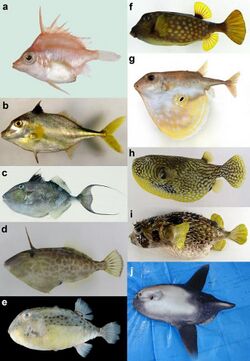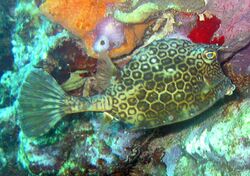Biology:Tetraodontiformes
| Tetraodontiformes | |
|---|---|

| |
| Representatives of the 10 extant Tetraodontiformes families: a Triacanthodidae, Triacanthodes anomalus; b Triacanthidae, Triacanthus biaculeatus; c Balistidae, Abalistes filamentosus; d Monacanthidae, Thamnaconus hypargyreus; e Aracanidae, Kentrocapros aculeatus; f Ostraciidae, Ostracion immaculatus; g Triodontidae Triodon macropterus; h Tetraodontidae, Arothron mappa; i Diodontidae, Diodon liturosus; j Molidae, Masturus lanceolatus | |
| Scientific classification | |
| Domain: | Eukaryota |
| Kingdom: | Animalia |
| Phylum: | Chordata |
| Class: | Actinopterygii |
| Clade: | Percomorpha |
| Order: | Tetraodontiformes L. S. Berg, 1940 |
| Type species | |
| Tetraodon lineatus | |
| Families | |
|
See text. | |
The Tetraodontiformes (/tɛtrə.ɒˈdɒntɪfɔːrmiːz/) are an order of highly derived ray-finned fish, also called the Plectognathi.[2] Sometimes these are classified as a suborder of the order Perciformes. The Tetraodontiformes are represented by 10 extant families and at least 349 species overall; most are marine and dwell in and around tropical coral reefs, but a few species are found in freshwater streams and estuaries. They have no close relatives, and descend from a line of coral-dwelling species that emerged around 80 million years ago.
Evolution
The oldest tetraodontiforms are the extinct superfamily Plectocretacicoidea from the Late Cretaceous (Santonian to Campanian) of Italy and Slovenia, both in the former Tethyan region. These comprise the families Cretatriacanthidae and Protriacanthidae. Plectocretacicus from the Cenomanian of Lebanon has also been proposed as a tetraodontiform, but this has been more recently questioned.[3][1]
Description
Various bizarre forms are included here, all radical departures from the streamlined body plan typical of most fishes. These forms range from nearly square or triangular (boxfishes), globose (pufferfishes) to laterally compressed (filefishes and triggerfishes). They range in size from Rudarius excelsus (a filefish), measuring just 2 cm (0.79 in) in length, to the ocean sunfish, the largest of all bony fishes at up to 3 m (9.8 ft) in length and weighing over 2 tonnes.[4]
Most members of this order – except for the family Balistidae – are ostraciiform swimmers, meaning the body is rigid and incapable of lateral flexure. Because of this, they are slow-moving and rely on their pectoral, dorsal, anal, and caudal fins for propulsion rather than body undulation. However, movement is usually quite precise; dorsal and anal fins aid in manoeuvring and stabilizing. In most species, all fins are simple, small, and rounded, except for the pelvic fins which, if present, are fused and buried. Again, in most members, the gill plates are covered over with skin, the only gill opening a small slit above the pectoral fin.
The tetraodontiform strategy seems to be defense at the expense of speed, with all species fortified with scales modified into strong plates or spines[5] – or with tough, leathery skin (the filefishes and ocean sunfish). Another striking defensive attribute found in the pufferfishes and porcupinefishes is the ability to inflate their bodies to greatly increase their normal diameter; this is accomplished by sucking water into a diverticulum of the stomach. Many species of the Tetraodontidae, Triodontidae, and Diodontidae are further protected from predation by tetrodotoxin, a powerful neurotoxin concentrated in the animals' internal organs.

Tetraodontiforms have highly modified skeletons, with no nasal, parietal, infraorbital, or (usually) lower rib bones. The bones of the jaw are modified and fused into a sort of "beak";[6] visible sutures divide the beaks into "teeth". This is alluded to in their name, derived from the Greek words τετρα- tetra meaning "four" and ὀδούς odous meaning "tooth" and the Latin forma meaning "shape".[5] Counting these teeth-like bones is a way of distinguishing similar families, for example, the Tetraodontidae ("four-toothed"), Triodontidae ("three-toothed"), and Diodontidae ("two-toothed").
Their jaws are aided by powerful muscles, and many species also have pharyngeal teeth to further process prey items, because the Tetraodontiformes prey mostly on hard-shelled invertebrates, such as crustaceans and shellfish.
The Molidae are conspicuous even within this oddball order; they lack swim bladders and spines, and are propelled by their very tall dorsal and anal fins. The caudal peduncle is absent and the caudal fin is reduced to a stiff rudder-like structure. Molids are pelagic rather than reef-associated and feed on soft-bodied invertebrates, especially jellyfish.
Families



This cladogram of extant Tetraodontiformes is based on Santini et al., 2013.[7]
| Tetraodontiformes |
| ||||||||||||||||||||||||||||||||||||||||||||||||||||||||||||||||||||||||||||||||||||
Fossil families
- Superfamily †Plectocretacicoidea Tyler & Sorbini, 1996[8]
- †Cretatriacanthidae Tyler & Sorbini, 1996[8]
- †Plectocretacicidae Tyler & Sorbini, 1996[8]
- †Protriacanthidae Tyler & Sorbini, 1996[8]
- †Bolcabalistidae (e.g. Eospinus) Santini & Tyler, 2003[9]
- †Eoplectidae
- †Moclaybalistidae Santini & Tyler, 2003[9]
- †Spinacanthidae
Timeline of genera
<timeline> ImageSize = width:1000px height:auto barincrement:15px PlotArea = left:10px bottom:50px top:10px right:10px
Period = from:-145.5 till:15 TimeAxis = orientation:horizontal ScaleMajor = unit:year increment:10 start:-145.5 ScaleMinor = unit:year increment:1 start:-145.5 TimeAxis = orientation:hor AlignBars = justify
Colors =
#legends id:CAR value:claret id:ANK value:rgb(0.4,0.3,0.196) id:HER value:teal id:HAD value:green id:OMN value:blue id:black value:black id:white value:white id:cretaceous value:rgb(0.5,0.78,0.31) id:earlycretaceous value:rgb(0.63,0.78,0.65) id:latecretaceous value:rgb(0.74,0.82,0.37) id:cenozoic value:rgb(0.54,0.54,0.258) id:paleogene value:rgb(0.99,0.6,0.32) id:paleocene value:rgb(0.99,0.65,0.37) id:eocene value:rgb(0.99,0.71,0.42) id:oligocene value:rgb(0.99,0.75,0.48) id:neogene value:rgb(0.999999,0.9,0.1) id:miocene value:rgb(0.999999,0.999999,0) id:pliocene value:rgb(0.97,0.98,0.68) id:quaternary value:rgb(0.98,0.98,0.5) id:pleistocene value:rgb(0.999999,0.95,0.68) id:holocene value:rgb(0.999,0.95,0.88)
BarData=
bar:eratop bar:space bar:periodtop bar:space bar:NAM1 bar:NAM2 bar:NAM3 bar:NAM4 bar:NAM5 bar:NAM6 bar:NAM7 bar:NAM8 bar:NAM9 bar:NAM10 bar:NAM11 bar:NAM12 bar:NAM13 bar:NAM14 bar:NAM15 bar:NAM16 bar:NAM17 bar:NAM18 bar:NAM19 bar:NAM20 bar:NAM21 bar:NAM22 bar:NAM23 bar:NAM24 bar:NAM25 bar:NAM26 bar:NAM27 bar:NAM28 bar:NAM29 bar:NAM30 bar:NAM31 bar:NAM32 bar:NAM33 bar:NAM34 bar:NAM35 bar:NAM36 bar:NAM37 bar:NAM38
bar:space bar:period bar:space bar:era
PlotData=
align:center textcolor:black fontsize:M mark:(line,black) width:25 shift:(7,-4) bar:periodtop from: -145.5 till: -99.6 color:earlycretaceous text:Early from: -99.6 till: -66 color:latecretaceous text:Late from: -66 till: -55.8 color:paleocene text:Paleo. from: -55.8 till: -33.9 color:eocene text:Eo. from: -33.9 till: -23.03 color:oligocene text:Oligo. from: -23.03 till: -5.332 color:miocene text:Mio. from: -5.332 till: -2.588 color:pliocene text:Pl. from: -2.588 till: -0.0117 color:pleistocene text:Pl. from: -0.0117 till: 0 color:holocene text:H.
bar:eratop from: -145.5 till: -66 color:cretaceous text:Cretaceous from: -66 till: -23.03 color:paleogene text:Paleogene from: -23.03 till: -2.588 color:neogene text:Neogene from: -2.588 till: 0 color:quaternary text:Q.
PlotData=
align:left fontsize:M mark:(line,white) width:5 anchor:till align:left
color:latecretaceous bar:NAM1 from:-99.6 till:-97.6 text:Plectocretacicus color:latecretaceous bar:NAM2 from:-74.9 till:-68.9 text:Cretatriacanthus color:latecretaceous bar:NAM3 from:-70.6 till:-48.6 text:Kankatodus color:paleocene bar:NAM4 from:-66 till:-55.8 text:Indotrigonodon color:paleocene bar:NAM5 from:-66 till:-55.8 text:Pisdurodon color:paleocene bar:NAM6 from:-66 till:-33.9 text:Eotrigonodon color:eocene bar:NAM7 from:-55.8 till:-48.6 text:Eospinus color:eocene bar:NAM8 from:-55.8 till:-33.9 text:Eodiodon color:eocene bar:NAM9 from:-55.8 till:-33.9 text:Eolactoria color:eocene bar:NAM10 from:-55.8 till:-33.9 text:Eoplectus color:eocene bar:NAM11 from:-55.8 till:-33.9 text:Eotetraodon color:eocene bar:NAM12 from:-55.8 till:-33.9 text:Proaracana color:eocene bar:NAM13 from:-55.8 till:-33.9 text:Prodiodon color:eocene bar:NAM14 from:-55.8 till:-33.9 text:Protacanthodes color:eocene bar:NAM15 from:-55.8 till:-33.9 text:Protobalistium color:eocene bar:NAM16 from:-55.8 till:-33.9 text:Spinacanthus color:eocene bar:NAM17 from:-55.8 till:-33.9 text:Zignoichthys color:eocene bar:NAM18 from:-55.8 till:-33.9 text:Progymnodon color:eocene bar:NAM19 from:-55.8 till:0 text:Amanses color:eocene bar:NAM20 from:-55.8 till:0 text:Diodon color:eocene bar:NAM21 from:-55.8 till:0 text:Triodon color:eocene bar:NAM22 from:-55.8 till:0 text:Ostracion color:eocene bar:NAM23 from:-48.6 till:0 text:Triacanthus color:oligocene bar:NAM24 from:-33.9 till:-28.4 text:Acanthopleurus color:oligocene bar:NAM25 from:-33.9 till:-28.4 text:Balistomorphus color:oligocene bar:NAM26 from:-33.9 till:-28.4 text:Cryptobalistes color:oligocene bar:NAM27 from:-33.9 till:-28.4 text:Oligobalistes color:oligocene bar:NAM28 from:-33.9 till:-28.4 text:Oligolactoria color:oligocene bar:NAM29 from:-33.9 till:-5.332 text:Oligodiodon color:oligocene bar:NAM30 from:-28.4 till:0 text:Aracana color:miocene bar:NAM31 from:-23.03 till:0 text:Marosichthys color:miocene bar:NAM32 from:-15.97 till:-2.588 text:Trigonodon color:miocene bar:NAM33 from:-15.97 till:0 text:Balistes color:miocene bar:NAM34 from:-15.97 till:0 text:Tetraodon color:miocene bar:NAM35 from:-11.608 till:0 text:Chilomycterus color:miocene bar:NAM36 from:-11.608 till:0 text:Mola color:pliocene bar:NAM37 from:-5.332 till:-2.588 text:Kyrtogymnodon color:pliocene bar:NAM38 from:-5.332 till:0 text:Alutera
PlotData=
align:center textcolor:black fontsize:M mark:(line,black) width:25
bar:period from: -145.5 till: -99.6 color:earlycretaceous text:Early from: -99.6 till: -66 color:latecretaceous text:Late from: -66 till: -55.8 color:paleocene text:Paleo. from: -55.8 till: -33.9 color:eocene text:Eo. from: -33.9 till: -23.03 color:oligocene text:Oligo. from: -23.03 till: -5.332 color:miocene text:Mio. from: -5.332 till: -2.588 color:pliocene text:Pl. from: -2.588 till: -0.0117 color:pleistocene text:Pl. from: -0.0117 till: 0 color:holocene text:H.
bar:era from: -145.5 till: -66 color:cretaceous text:Cretaceous from: -66 till: -23.03 color:paleogene text:Paleogene from: -23.03 till: -2.588 color:neogene text:Neogene from: -2.588 till: 0 color:quaternary text:Q.
</timeline>
References
- ↑ 1.0 1.1 Cite error: Invalid
<ref>tag; no text was provided for refs named:0 - ↑ Tyler, James C (1980). Cover of: Osteology, phylogeny, and higher classification of the fishes of the order Plectognathi (Tetraodontiformes) by James C. Tyler Osteology, phylogeny, and higher classification of the fishes of the order Plectognathi (Tetraodontiformes). NOAA. https://archive.org/details/osteologyphyloge00tyle.
- ↑ Tyler, James C.; Tyler, James C.; Sorbini, Lorenzo; Institution, Smithsonian (1996). New superfamily and three new families of tetraodontiform fishes from the Upper Cretaceous : the earliest and most morphologically primitive plectognaths. Washington, D.C: Smithsonian Institution Press. https://www.biodiversitylibrary.org/bibliography/159035.
- ↑ Matsuura, Keiichi; Tyler, J.C. (1998). Encyclopedia of Fishes. San Diego, California, USA: Academic Press. pp. 230. ISBN 978-0-12-547665-2.
- ↑ 5.0 5.1 "Order Summary for Tetraodontiformes". 2023. https://fishbase.mnhn.fr/Summary/OrdersSummary.php?Order=Tetraodontiformes.
- ↑ Ponder, Winston Frank; Lindberg, David R.; Ponder, Juliet Mary (2019). Biology and Evolution of the Mollusca. 1. Boca Raton, Florida, USA: CRC Press. ISBN 978-1-351-11565-0. https://books.google.com/books?id=UjL3DwAAQBAJ&pg=PA523.
- ↑ Santini, Francesco; Sorenson, Laurie; Alfaro, Michael E. (2013). "A new phylogeny of tetraodontiform fishes (Tetraodontiformes, Acanthomorpha) based on 22 loci". Molecular Phylogenetics and Evolution 69 (1): 177–187. doi:10.1016/j.ympev.2013.05.014. PMID 23727595. https://doi.org/10.1016/j.ympev.2013.05.014.
- ↑ 8.0 8.1 8.2 8.3 Tyler, James C.; Sorbini, Lorenzo (1996). "New Superfamily and Three New Families of Tetraodontiform Fishes from the Upper Cretaceous: The Earliest and Most Morphologically Primitive Plectognaths". Smithsonian Contributions to Paleobiology 82 (82): 1–59. doi:10.5479/si.00810266.82.1. https://repository.si.edu/bitstream/handle/10088/1998/-0082-Lo_res.pdf?sequence=2&isAllowed=y.
- ↑ 9.0 9.1 Santini, Francesco; Tyler, James C. (2003). "A phylogeny of the families of fossil and extant tetraodontiform fishes (Acanthomorpha, Tetraodontiformes), Upper Cretaceous to Recent". Zoological Journal of the Linnean Society 139 (4): 565–617. doi:10.1111/j.1096-3642.2003.00088.x.
- Tree of Life: Tetraodontiformes
- Sepkoski, Jack (2002). "A compendium of fossil marine animal genera". Bulletins of American Paleontology 364: 560. http://strata.ummp.lsa.umich.edu/jack/showgenera.php?taxon=611&rank=class. Retrieved 2011-04-21.
Wikidata ☰ Q211837 entry
 |



